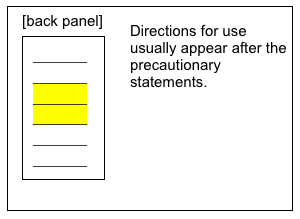Label Review Training: Module 3: Special Issues, Page 11
Section 3: What are directions for use?
Purpose of Directions for Use
Directions for use take up more space on the label than any other part. They describe how the product can legally be used and how  the product must not be used. In general, directions for use must include the following information:
the product must not be used. In general, directions for use must include the following information:
- The site(s) where the product can be used.
- The pest(s) that the product may be used to control.
- The application methods that are required or preferred.
- How much pesticide can be applied and the rate of application.
- Whether there are any restrictions on use for factors such as weather, time of day, season of the year, contamination of sensitive areas, and exposure of non-target species.
- The application methods that are prohibited.
- How often the pesticide should or can be applied.
- Maximum application rates (per treatment and per year).
- All restricted entry intervals pertaining to existing uses, as applicable.
- Pre–harvest intervals.
- Any other requirements for use of the product that will increase effectiveness and reduce risk, as necessary.
Not only should the directions for use provide basic application information, its contents must also make sense. Any user, and especially the general consumer, who is a nontechnical and occasional user, should be able to easily understand and follow the directions for use. Sentences should be written to indicate whether any actions mentioned are mandatory (required or prohibited) or simply advisory (encouraged or discouraged).
Resources
For more information about directions for use, see Chapter 11 of the Label Review Manual. To calculate rates, use the application rate calculator. Exit
Page 11 of 43
Previous Page Next Page
